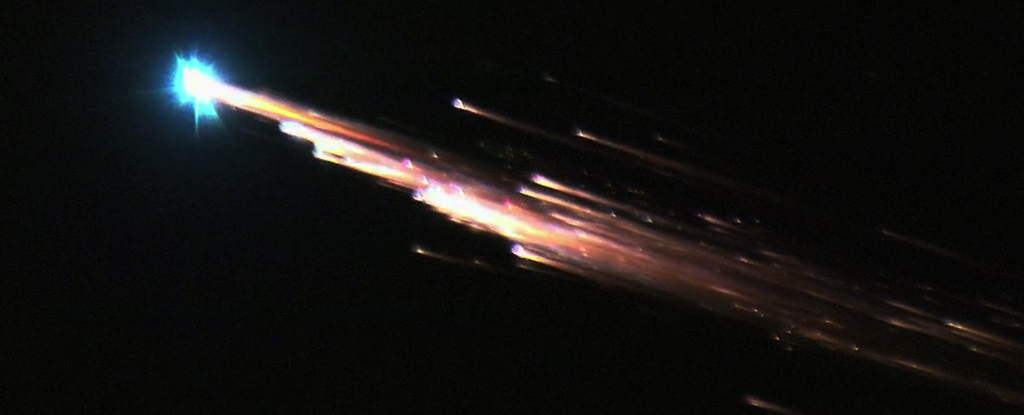Communications companies like Starlink plan to launch tens of thousands of satellites into Earth orbit over the next decade. The growing swarm is already causing problems for astronomers, but recent research has raised another question: What happens when they start to descend?
When these satellites expire, they will fall into the Earth’s atmosphere and burn up. They will leave a trail of small metal particles along the way. This satellite shower could blast 360 tons of tiny aluminum oxide particles into the atmosphere each year, according to a study published last week by a group of American researchers.
The aluminum will mostly be injected at an altitude of 50 to 85 kilometers, but will then drift into the stratosphere, where the Earth’s protective ozone layer is located. What does it mean? The satellite’s backscatter may contribute to chemical reactions that deplete ozone, according to the study. This is not true, but as we will see, the story is far from simple.
How is ozone destroyed?
Ozone loss in the stratosphere is caused by “free radicals” (atoms or molecules with free electrons). When radicals form, they start cycles that destroy many ozone molecules. (These cycles have names that Dr. Seuss would admire: NOx, HOx, ClOx, and BrOx, because they all contain oxygen as well as nitrogen, hydrogen, chlorine, and bromine, respectively.)
These radicals are formed when stable gases are broken down by ultraviolet light, which is abundant in the stratosphere. Nitrogen oxides (NOx) start with nitrous oxide. It is a greenhouse gas naturally produced by microbes, but fertilizer production and agriculture have increased its amount in the air.
The HOx cycle involves hydrogen radicals from water vapor. Small amounts of water vapor enter the stratosphere, but events such as the underwater eruption of the Hunga Tonga-Hunga Haapai volcano in 2022 can occasionally release large amounts of water vapor. Water in the stratosphere creates many tiny aerosol particles that create a large surface area for chemical reactions and also scatter more light, creating beautiful sunsets. (I will return to these two points later.)
How did Freons create the “ozone hole”?
ClOx and BrOx are the cycles responsible for the best-known damage to the ozone layer: the “ozone hole” caused by chlorofluorocarbons (CFCs) and halons. These now-banned chemicals were widely used in refrigerators and fire extinguishers, causing chlorine and bromine to spread into the stratosphere. Freons rapidly release chlorine radicals in the stratosphere. However, this reagent is quickly neutralized with the help of chlorine, nitrogen and water radicals and locked within the molecules.
What happens next depends on aerosols in the stratosphere as well as clouds near the poles.
Aerosols accelerate chemical reactions by creating a surface on which they form. As a result, aerosols in the stratosphere emit active chlorine (and bromine). Polar stratospheric clouds also remove water and nitrogen oxides from the air. So in general when there are more stratospheric aerosols around, we will probably see more ozone loss.
The stratosphere is becoming increasingly metallic
The details of the specific injection of aluminum oxide by crashed satellites would be quite complex. This is not the first study to highlight increased pollution of the stratosphere due to re-entry of space debris.
Researchers examining aerosol particles in the stratosphere in 2023 discovered traces of metal during the re-entry of a spacecraft. They found that 10 percent of stratospheric aerosols already contain aluminum and predicted that this amount will increase to 50 percent in the next 10 to 30 years. (About 50 percent of stratospheric aerosol particles already contain metals from meteors.)
We don’t know what impact it will have. One possible outcome could be that aluminum particles cause ice-containing particles to grow. This means there will be smaller, cooler, reflective particles with more surface area on which chemistry can occur.
We also don’t know how aluminum particles will interact with sulfuric acid, nitric acid, and water in the stratosphere. As a result, we cannot say exactly what the consequences of ozone loss will be.
Learning from volcanoes
To truly understand how these aluminum oxides affect ozone loss, we need laboratory studies to model the chemical process in more detail and see how the particles will move through the atmosphere.
For example, after the Hunga Tonga-Hunga Ha’apai eruption, water vapor in the stratosphere rapidly mixed in the southern hemisphere and moved towards the poles. At first, this extra water caused intense sunsets, but after a year these water aerosols became well diluted in the southern hemisphere and we can no longer see them.
A global current called the Brewer-Dobson circulation moves air into the stratosphere near the equator and back towards the poles. As a result, aerosols and gases cannot remain in the stratosphere for more than six years. (Climate change is accelerating this circulation, which means the time that aerosols and gases remain in the stratosphere is shortening.)
The famous eruption of Mount Pinatubo in 1991 also resulted in beautiful sunsets. It blasted more than 15 million tonnes of sulfur dioxide into the stratosphere, cooling the Earth’s surface by just over half a degree Celsius in about three years. The event inspired geoengineering proposals to slow climate change by deliberately inserting sulfate aerosols into the stratosphere.
Many questions remain
360 tons of aluminum oxide seem like small potatoes compared to Pinatubo’s 15 million tons. But we don’t know how aluminum oxides will behave physically in the stratosphere. Will it create smaller and more reflective aerosols and thus cool the surface, similar to geoengineering scenarios involving the injection of aerosols into the stratosphere?
We also don’t know how aluminum will behave chemically. Will it form ice nuclei? How will it interact with nitric and sulfuric acids? Will it contribute to ozone depletion by releasing trapped chlorine more effectively from existing stratospheric aerosols?
And of course aluminum aerosols won’t stay in the stratosphere forever. What will this metallic pollution do to our polar regions when they eventually fall to earth? All these problems need to be solved. By some estimates, more than 50,000 satellites could be launched between now and 2030, so we need to get our hands on them as soon as possible.













